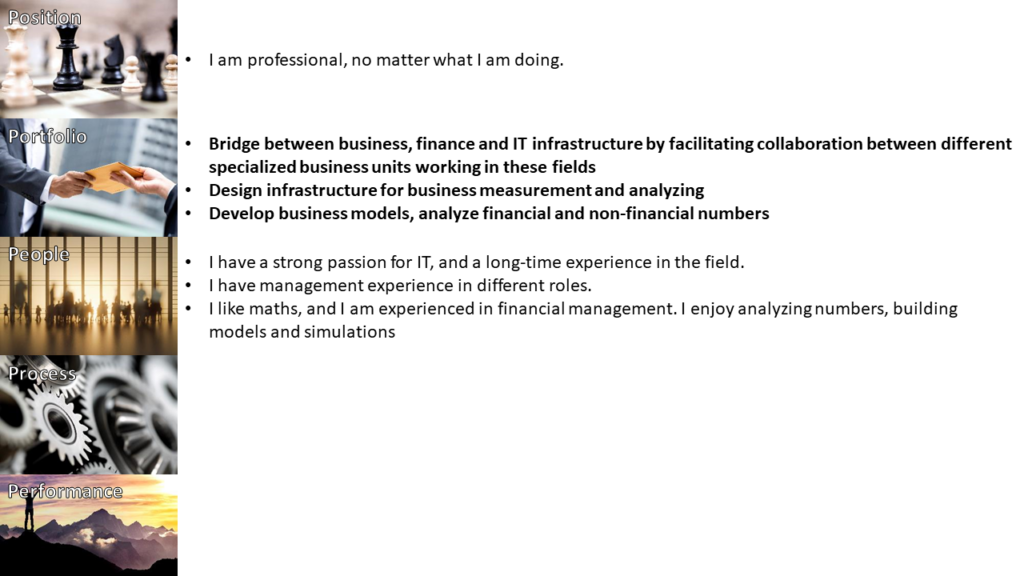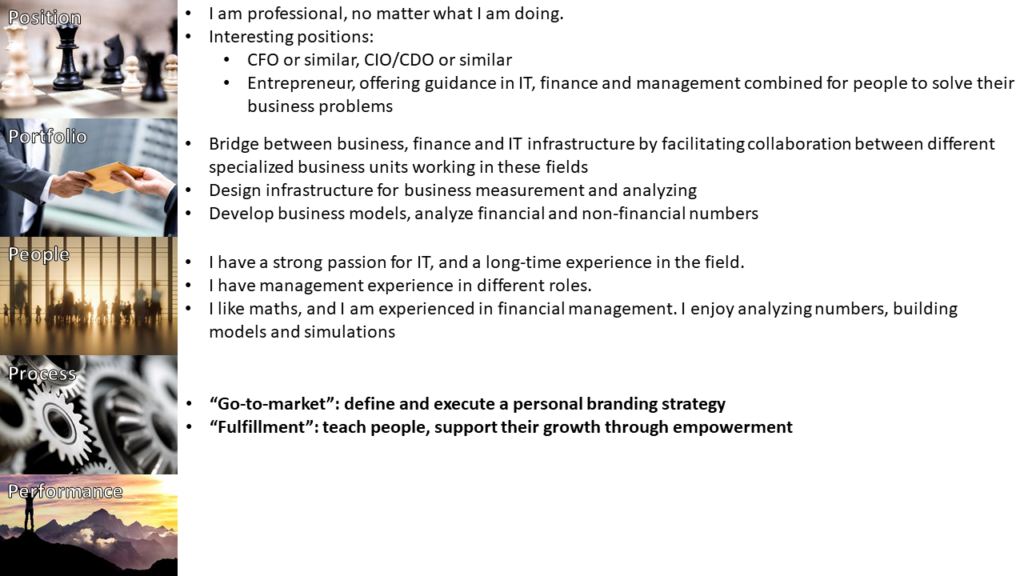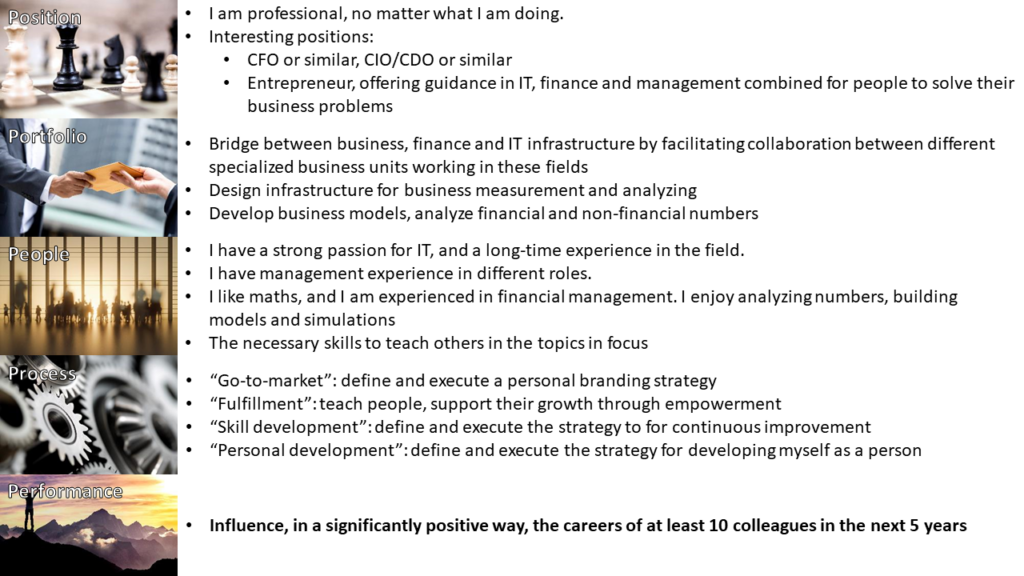Career planning is an important topic for the majority of professionals. It is a personal matter, therefore it is a good opportunity to show how a model initially designed for solving business situations can be used in a personal context: defining the career strategy.
As in the previous example, we will focus on the thinking process taking advantage of the links between the model’s components.
Stage 1 – Position – first idea
The usual start in 5P synthesis is the Position. I don’t have yet a clear picture, but I know I want to be a professional, no matter what I am doing, leading to the first entry in the 5P model:

Very generic, it needs refinement, but it is good enough for a starting point.
Stage 2 – People – identify my interest and strong points
The next thing I should clarify is WHAT I want to do. Defining the Portfolio. In this situation, I prefer first to think of my strengths and interest, so I jump instead to People:
- I have a strong passion for IT, and a long time experience in the field.
- I have management experience in different roles.
- I like math, and I am experience in financial management. I enjoy analyzing numbers, building models and simulations
These are three aspects I should “exploit”, and they start to fill the 5P overview

Stage 3 – Portfolio – reflect my strong points
Combining these three People topics leads me to defining my first Portfolio elements:
- I offer the bridge between the business, financials of that business and IT infrastructure needed by that business by facilitating collaboration between different specialized business units working in these fields.
- I design the infrastructure for business number gathering and analyzing.
- I develop business models, I analyze financial and non-financial numbers.
Of course, this statement is still too generic, and needs further details. They can be defined by going back and forth between People aspects and Portfolio aspects, and I will not get into all these details to keep the example reasonably simple.

Stage 4 – Position – Identify in which context I can use my Portfolio items
Having the idea on my Portfolio, I can return to the Position and consider in WHICH CONTEXT can I ensure the bridge between business, financials and IT?
- I can position myself as a CFO or similar role in an organization
- I can position myself as a CIO/CDO or similar role in an organization
- I can become an entrepreneur offering advisory services in these fields combined, and guiding people solve their business problems.
These positioning details, combined with my original idea, gives me a mid- and long-term direction. Even in such cases, I could “segment target market further”: which are the profiles of the companies I could work in a management position, or what kind of company can I found to offer advising. The points above complete the picture in the Position section:

Stage 5 – Processes – How to “sell” myself, how to fulfill my offer
We covered so far the Position, Portfolio and People aspects in a reasonable level of details for an example. It is time to move to the Process.
HOW can I increase the awareness of my services, either as employee or as an entrepreneur? This is similar with a go-to-market approach of a business, in the end. Well, I could think of
- Define and execute a personal branding strategy
Another important aspect is the fulfillment part: HOW can I provide the services in my portfolio in a meaningful way? One way is to
- Teach people, support their growth through empowerment
… partially filling the Process section:

Stage 6 – People – Complete the skills, acquire the skills
This stage brings me back to the People aspects. Do I have The necessary skills to teach others the topics in focus, like teaching skills, clarity in communication? This will then lead me back to the Processes, to define The strategy to acquire the needed skills for teaching others:

Stage 7 – People – Adjust the skills needed
Before going to the next P, I make a review – do I cover with Processes all the previous points? It seems that my initial idea on Positioning – be professional no matter what I am doing – requires some additional thoughts.
On one hand, the mindset and attitude must be the right one, so I should think if I want to make some changes using personal development: Define and execute the strategy for developing myself as a person.
On the other hand, being a professional needs implies good specialized and general skills, and this is done through continuous improvement (what I would like to learn, how I would like to learn, how can I learn from my mistakes, etc.), which means an additional topic related to people aspects: Define and execute a strategy for continuous improvement.

Stage 8 – Performance – what is a successful career?
I am getting towards the end of a first definition cycle. And this is the Performance. If in the case of the business, the first thing to define is the financial success, when talking about career it might not be so straigt forward.
I think of the Performance aspects as what makes me consider the career as successful. One option is the financial success, however it can be defined (e.g. earnings per year). However, there may be other criteria of success, less obvious.
I like to be as specific as possible, so I can also track the progress, so one Performance indicator I could think of is Influence in a significant positive way the careers of at least 10 colleagues in the next 5 years.
Without getting into more details, the career planning picture after the first thinking exercise looks like:

The Conclusions
The example prezented above is just the starting point. Of course, the plan can be further detailed and completed in subsequent iterations.
It may look exagerated or “artificial” to use a tool designed for business situations in personal matters. Even so, it worths a try, you may find it useful for clarifying your goals and how to achieve them.
The Summary
The sliders below show the brief development of the plan during the first iteration used as an example.
